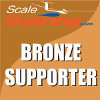Three of us in SoCal recently received our FW Models ASW-17 racers. 1/3 scale, 6.6 meter span, airfoil optimized for GPS Triangle competition. Two ballast tubes in each wing. Ordered it without linkages or wiring, so everything can be set up exactly as desired. The molding, paint work and parts fit is outstanding...some of the best I have ever seen.
I will be using PowerBox equipment for battery and servo management, dual redundant JR DMSS RXs, and a JR/DeeForce T14X4 radio (same as JR XG-14.) Looking forward to getting this one on the GPS course.
I will be using PowerBox equipment for battery and servo management, dual redundant JR DMSS RXs, and a JR/DeeForce T14X4 radio (same as JR XG-14.) Looking forward to getting this one on the GPS course.



Comment